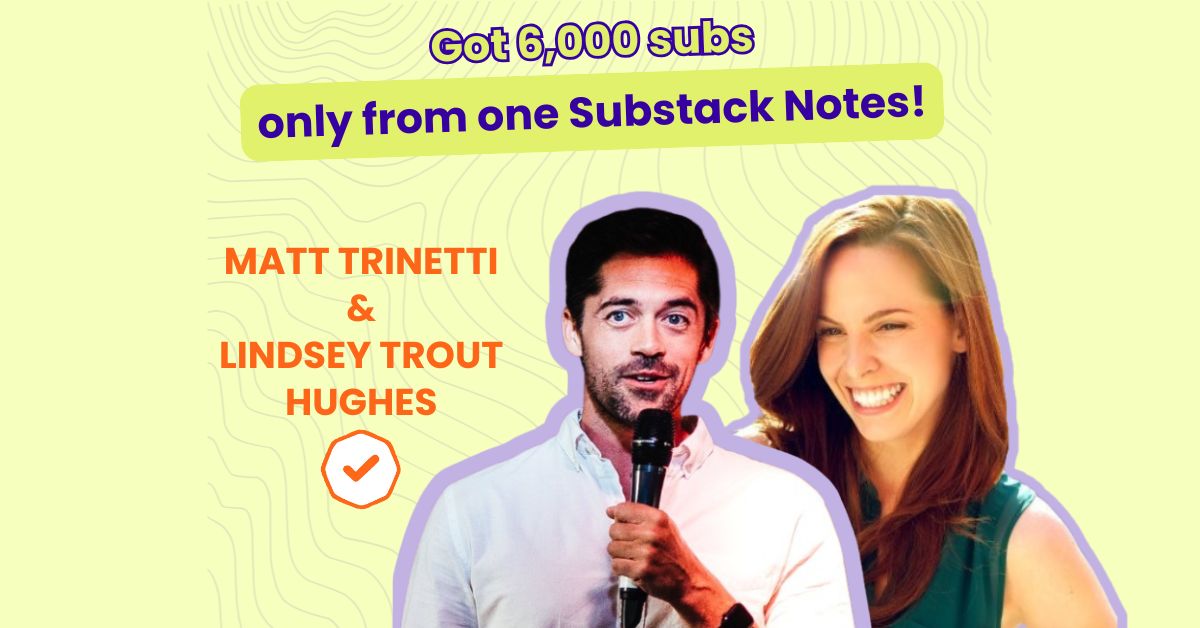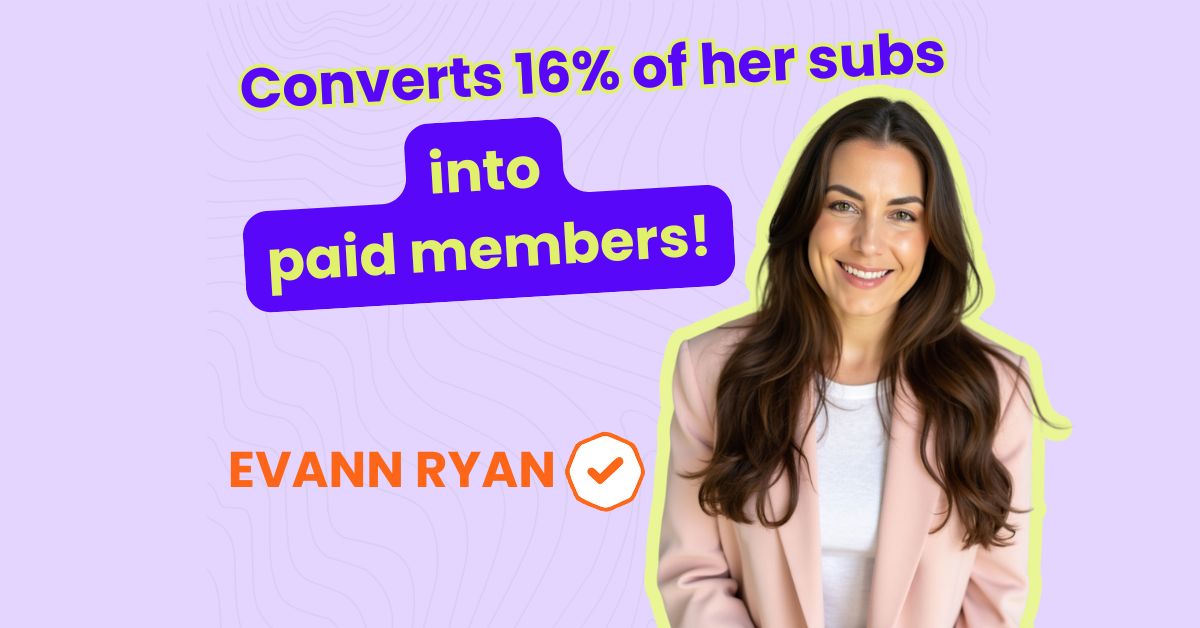Interview Date: May 21, 2023
Table of Content
CREATOR INTERVIEW
Today we welcome Ozan Irturk, the creator of Life-Changing Concepts, a weekly newsletter sharing mental models that give founders an unfair advantage in business.
Ozan left his corporate job as a Product Manager to focus on his blog and newsletter and since then, he has been successfully building his creator business.
From the first moment you read his articles, you feel the great effort behind each piece and the high quality of the newsletter makes you read more and more.
But Ozan also knows that creating great content alone is not enough. He loves experimenting with diverse growth strategies and his iterations made him reach 11,000+ subscribers and 5-figure yearly income in two years.
So, in addition to key growth and monetization strategies he utilizes, today you’ll get some unique insights such as:
- How he gained 1,500 subscribers from the Product Hunt launch, his learnings, tips & tricks to get well-prepared
- How he increased landing page conversion by ~10% by leveraging lead magnets
- How he utilized “Share this article” button
- The ideal number of referrals for the first gift
- Recommendations of effective growth strategies according to different list sizes
- The iterations he made to start a premium subscription
- His detailed weekly process to research and release informative articles
Let’s start!
NEWSLETTER IDENTITY CARD
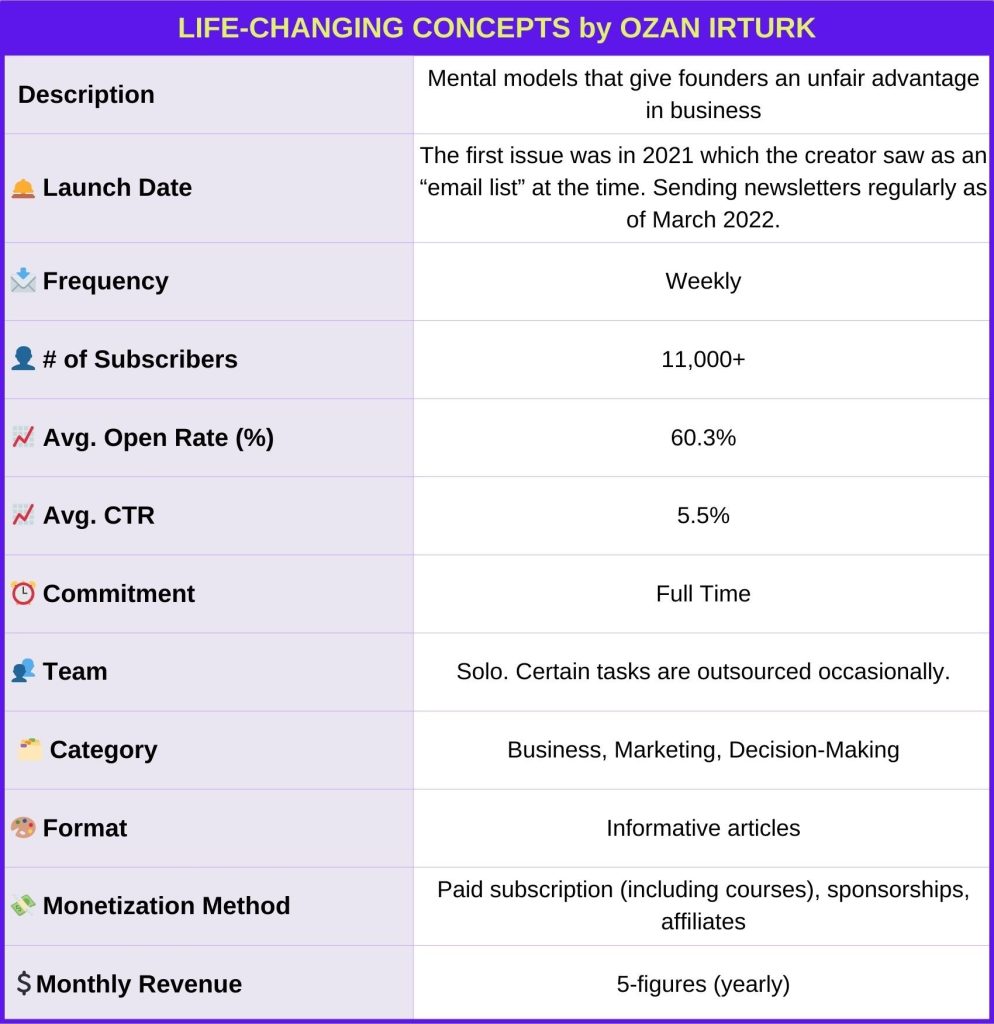
TOOL STACK
- ESP → ConvertKit
- Writing → Notion
- Idea Capture & Note Taking → Notion, Apple Notes, Pocket
- Design → Figma
- Growth → SparkLoop
- Payment → Stripe, Gumroad
- Website → WordPress
- SEO→ GSC, Yoast, Ahrefs
MEET THE CREATOR
Welcome Ozan. Let’s start with getting to know you.
Hey, I’m Ozan, founder of Frontera. I live in Barcelona.
I was a product manager in the aviation industry, managing a B2B platform with more than 100,000 users. Last year, I decided to leave my corporate job and focus full-time on the blog and Life-Changing Concepts.
I’m an Industrial Engineer (though never practiced it).
START
What is Life-Changing Concepts all about?
Life-Changing Concepts is all about giving founders a competitive advantage in business with mental models.
I believe knowledge is power and mental models can help entrepreneurs achieve better results. So I distill these useful ideas in an actionable way with Life-Changing Concepts.
It’s at the intersection of business, marketing, and decision-making.
Why and how did you decide to start Life-Changing Concepts newsletter in the first place?
I realized a problem.
Most writings on mental models were full of jargon, lengthy and boring. They were useful but hard to consume.
So I started Life-Changing Concepts to explain mental models in a way I’d want to read myself: explained through business stories and real-life examples.
Can you take us through how you build the first version of Life-Changing Concepts?
Let me answer this with the story of the name.
When I started creating content, I quickly realized it’s hard to choose what to write about every day/week.
Then I read a sentence in Steven Pressfield’s book.
When he worked at an advertising agency as a copywriter, somebody told him: “Don’t think in ads, think in campaigns.”
“So instead of thinking about what to write one by one, I decided to see the newsletter as a campaign. What could I write about for a long time, week after week? My answer became the name of the newsletter: Life-Changing Concepts.”
After that, the first edition was easy.
I chose one concept and started writing.
But of course, later on I had to iterate to figure out the right format to explain those concepts.
How did you gain your first 1000 subscribers?
My first 200 subscribers came from Instagram (brand account).
After that, three of my articles made it to the first page of HackerNews and brought like 600-700 subscribers.
Then one post got viral on Reddit.
These brought me the first 1000 subscribers.
GROWTH
Which growth channels do you mainly use?
I experimented with almost everything. But currently using a mix of cross-promotions, SEO, Sparkloop, and paid ads.
What are the most effective growth strategy & channels?
It depends on at which stage the newsletter is.
If paid growth is not an option early on, you have to distribute content aggressively on social media and other platforms to get the first 1000 subscribers.
After a few thousand subs, cross-promotions work well.
But to scale a newsletter beyond 100k+ (without a huge audience somewhere else) you have to figure out either paid growth or SEO.
How did your growth strategy evolve in parallel to your subscriber list growth?
At first, I depended on free channels.
But as the list grew and I started monetizing, I started experimenting with paid growth. So growth strategy depends a lot on monetization. The better you monetize, the easier it gets to grow.
This year word-of-mouth also became a serious growth channel.
Some time ago, I realized many readers were forwarding the emails to their friends. So to make it easier, I added a “Share this article” button at the end of each edition (linking it to the same article on the blog). This simple change increased shares (and even backlinks) a lot.
How do you leverage the referral program? What are your learnings?
I have an automated mail to inform new subscribers about the referral program (two weeks after they join).
I also add it as a section to the newsletter from time to time.
So far, results have been okay.
I haven’t experimented enough with the gifts.
“But I experimented with the number of referrals for the first gift and one referral worked the best.”
How do you leverage lead magnets? What are your learnings?
I give a summary of 20 useful mental models to all new readers, as a welcome gift.
I initially created it to see if it was going to have an impact on the newsletter landing page conversion.
And it increased the conversion by ~10%. So I added it as an incentive to all forms and created a popup.
But there are also other benefits.
First, some readers share the document with their friends — and I encourage them to do so if they like it.
I saw one person even sharing the whole document on Linkedin. So their friends also join the newsletter.
Second, it’s a great way for a new reader to get familiar with the content.
I see the readers who downloaded the mental model guide in the welcome email stay more engaged later on.
But it’s important to do it right.
“The lead magnet has to be closely related to the newsletter’s content and it should be an incentive for the readers to subscribe to the newsletter. Not a trap to capture emails and add readers to a newsletter that they didn’t want to join.”
You also launched Life-Changing Concepts on PH recently. Can you shortly mention how you prepared it, results and learnings?
Life-Changing Concepts finished the day in 4th place and it also became the 3rd product of the month in the marketing category.
I got around 1,500 subscribers from the launch.
Most of them joined on the launch day and the day after (Product Hunt sends a newsletter with the top 10 products of the previous day).
And the rest came in the 15 days after the launch.
So overall, it was worth the effort.
Learnings
- Product Hunt has a particular community.
“A big audience on other platforms doesn’t necessarily translate into a launch success so it’s important to connect with active people on PH before the launch.”
- Choosing the day depending on your goal is important.
My goal was to get subscribers — not become the first product of the day.
“So I launched on a competitive but also high-traffic day (Thursday) instead of a weekend.”
- Copy and visuals matter.
Product Hunt now randomizes the sorting of products and hides upvote counts on the home page in the first four hours. That gives more visibility to all products and makes things fairer, especially for solo founders.
“So if you have a catchy tagline and good visuals that explain the product well, you can get many upvotes early on.”
How I prepared
- I spent a few weeks on the platform to figure out how things work. I also read the official guides from the Product Hunt team.
- I connected with other makers and active members before the launch. Especially the ones that had a launch right before and after my launch date. When you support their launch, they happily reciprocate.
- I set up a teaser page and informed my subscribers before the launch. Also sent the newsletter right at 9:01 am PT time on the launch day asking for support.
- I prepared a list of people I know who use PH. I reached out on the launch day.
- I posted the launch on different communities and WhatsApp, Telegram, and Slack groups.
Regarding growth efforts, what would you do differently if you had a chance to start over?
If I were to start a new newsletter today, I would:
- Nail the format and value proposition as soon as possible
- Monetize with sponsorships and affiliates early on
- Grow it with paid ads, while building backlinks for SEO (if the content is evergreen).
MONETIZATION
How do you make money with your newsletter? Can you share the breakdown of your revenue streams?
I have a Premium subscription where members get a premium newsletter and two courses a year.
That’s the main revenue stream.
The others are affiliates and sponsorships for Life-Changing Concepts.
I’ve also made some consulting about writing, newsletter growth, and product strategy/positioning. But I do those on request and I’m not actively promoting it as I’m mindful of time.
Could you take us through your monetization journey?
I experimented with a few mini-products early on. They did okay.
Then I decided to test a paid newsletter — Distilled.
But I didn’t know if the value proposition would work.
So before promoting it to my subscribers, I created a landing page and a Facebook ad (with a lookalike audience) and tried to sell it.
I didn’t even have the first edition written, I only set up a welcome mail.
It worked.
So I wrote the first edition and started promoting it to existing readers after I had the first sales.
I like experimenting, so after a while, I changed it and created Frontera Premium with additional content.
That worked even better.
In parallel, I had started monetizing Life-Changing Concepts with affiliates.
And a few months ago I also added sponsorship.
I didn’t add sponsorships earlier because it’s a weekly newsletter — hence has fewer ad slots than a daily newsletter.
So the amount I could earn at the time wasn’t worth the effort.
How do you find sponsors?
So far sponsors have been inbound from the newsletter and website. But I’ve started reaching out to potential sponsors and closed some placements for the upcoming weeks.
How much do you charge for sponsorship?
I charge $50 CPM per 1000 sends.
I could increase it based on the clicks I sent (and subscriber quality).
But for now, I’d like to build relationships with sponsors rather than getting the maximum return.
Do you have any plans to increase your revenue?
Short-term, nailing the sponsorship revenue.
E-MAIL SERVICE PROVIDER
Why did you choose ConvertKit? Pros and cons?
I chose ConvertKit because of the automation features and good deliverability.
Its visual automation helps a lot to automate certain tasks like welcome sequence, subscriber tagging (and triggering actions) based on behavior, and referral program.
I’m happy with it and I’d recommend it to newsletter operators who see it as a business.
Three cons:
- Higher price compared with other ESPs
- Limited analytics where you can’t track UTM parameters in the platform
- Mostly a single-player platform. You can’t collaborate with other newsletters (though they are improving it).
SYSTEM & PRODUCTIVITY
What is your typical weekly process from creating to releasing a new issue?
- Ideation
I have a big list of ideas and stories. I choose ideas from that list and decide on the content calendar for the next month.
So when a new week comes, I know what to write about.
- Research
I read (or re-read) books and articles about the topic.
I find how the idea was born. And how people applied in business and real life.
I have to truly understand an idea to be able to add my insights and explain it in simple language. So sometimes research takes a lot of time.
As an example: to write about the flywheel effect, I read Jim Collins’ two books.
The concept was much more profound than I expected.
Or while writing about the priming effect, I had a lot of notes from books I read before.
But during research, I discovered some counterpoints and I had to read other research papers to validate if my examples were still scientifically solid.
- Writing
After research, I write a quick first draft.
It’s usually bad…
But it allows me to see the parts that are still not clear in my mind.
So I continue writing the second and third drafts.
The third one is the final one to publish.
NEWSLETTER EXPERIENCE
How did writing Life-Changing Concepts contribute to your life professionally & personally?
It’s been great.
I write about topics I enjoy learning myself.
So writing Life-Changing Concepts is the perfect way for me to make it a lifestyle.
And professionally, seeing the newsletter as a business (rather than a hobby) and trying to grow it has taught me a lot.
Marketing, growth, copywriting…
I’ve learned much more in a year than I could learn in a corporate job.
What is the most challenging part of writing a newsletter and how do you handle it?
The most challenging part of writing a newsletter is… writing it.
If you have high standards, it’s a painful process to get it right.
But you have to go through it.
It’s like lifting weights.
You do that last three squat reps despite your brain shouting “STOP!” to grow muscle.
And after the training, you feel great.
I feel the same after finishing a piece.
And how do I make it easy?
“I accept that it cannot be perfect. It only has to be good enough (for me). This reduces the pressure.”
Can you tell us one big mistake you made during your newsletter journey?
I use WordPress for the blog.
So when I decided to start the newsletter, I researched newsletter tools that can integrate properly with WordPress. And I found a WordPress plugin that was easy to set up. I said why not, let’s give it a try.
Oh, that was terrible. It took ages to send emails to 200 people.
And the open rates were like 25% as it was using my own —and at the time, new— domain.
So I corrected the mistake by switching to ConvertKit. My open rates immediately jumped to 50%.
It’s funny looking from today.
FUTURE
What is next on your newsletter journey?
Faster growth and better monetization are obvious goals.
Besides that, I don’t have a master plan. I have more questions than answers.
Should I continue keeping some of my content gated? Or would I be better off if I make everything free, grow faster, and monetize only through sponsorships?
Should I increase the newsletter frequency? Or is it already optimal?
I have a valuable audience, should I create a community? Or will it be too much work?
“I don’t know the answers. So I’ll experiment, learn, and adjust.”
RECOMMENDATIONS
What would it be if you had the right to give one piece of advice to aspiring newsletter creators?
“Find who cares about your content the most. Who is willing to even pay for it? And what is “the job” they are trying to get done? Find the answers and position your newsletter accordingly.”
In my case, it was the founders who wanted to get ahead.
After I got this insight, I changed everything. The messaging, website copy, landing pages, etc.
It gave a clear purpose to Life-Changing Concepts. Conversion (both for the newsletter and Premium subscription) increased.
Long story short: find the purpose of your newsletter.
Everything becomes easier when you know why people read your content.
What are your favorite newsletters that you can’t wait for the next issue?
I’m subscribed to hundreds of newsletters.
And try to catch up with them as much as possible.
Some of my favorites:
- CB Insights
- BrainPint
- The Future Party
- Growth In Reverse and…
- Newsletter Circle (the 6 AM City interview was my favorite).
FINAL WORDS
This was fun, thank you for having me Ciler!
And keep up the great work with Newsletter Circle.

